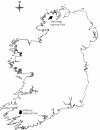Babesias of red deer (Cervus elaphus) in Ireland
- PMID: 21314977
- PMCID: PMC3037898
- DOI: 10.1186/1297-9716-42-7
Babesias of red deer (Cervus elaphus) in Ireland
Abstract
Blood samples were obtained from 38 wild red deer (Cervus elaphus) at two sites in Ireland and subjected to PCR analysis of the 18S rRNA gene followed by sequencing. Two fragments of the 18S rRNA gene were generated by two different PCR protocols and subsequent sequencing suggested that at least six of the deer were infected by a babesia that, in those loci, is indistinguishable from Babesia divergens, an important tick-borne pathogen of cattle and of zoonotic significance. Additionally, a B. odocoilei-like parasite was detected in three samples and a babesia that did not match any sequences in the GenBank database was found in five samples. Neither B. capreoli nor B. venatorum (EU1) were found. There have been several reports of B. divergens occurring in deer species, including red deer, roe deer (Capreolus capreolus) and reindeer (Rangifer tarandus). However, in view of recent re-sequencing of bovine-origin samples deposited previously in GenBank, it is unlikely that any of these sequences from deer are B. divergens. The present study describes the only deer piroplasm detected so far that shows complete identity with B. divergens, in just over half of the 18S rRNA gene. The entire gene of this deer parasite should be analysed and transmission experiments undertaken before the infectivity of B. divergens for red deer can be confirmed.
Figures



References
-
- Gray JS, Murphy TM, Taylor SM, Blewett DA, Harrington R. Comparative morphological and cross transmission studies with bovine and deer babesias in Ireland. Prev Vet Med. 1990;9:185–193. doi: 10.1016/0167-5877(90)90065-P. - DOI
-
- Enigk K, Friedhoff K. Babesia capreoli n. sp. in the deer (Capreolus capreolus L.) Z Tropenmed Parasitol. 1962;13:8–20. In German. - PubMed
MeSH terms
Substances
Associated data
- Actions
- Actions
- Actions
- Actions
LinkOut - more resources
Full Text Sources
Molecular Biology Databases

